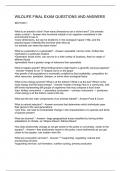WILDLIFE FINAL EXAM QUESTIONS AND ANSWERS
SECTION 1 What is an animal's niche? How many dimensions can a niche have? Can animals share a niche? - Answer-•the functional role/job of an organism considered in the environment it lives in
•many dimensions, but can be divided to 3: the ecological 'space' it fills, and the physical space it literally fills and time when they do
•no animals can share the same niche!
What is a specialist vs a generalist? - Answer-•specialist: narrow niche, limited diet, restricted to a particular location
•Generalist: broad niche, can survive in a wide variety of locations, feed on range of different foods
•generalists have a greater range of tolerance than specialists
What is logistic growth? What limiting factors might lead to a given(K) carrying capacity?
- Answer-•makes for an "s" shaped curve on the graph
•the growth of all populations is eventually curtailed by food availability, competition for other resources, predation, disease, or some other ecological factor.
What is the energy pyramid? What is at the bottom? What is at the top? Where is the most energy and the least energy? - Answer-•model of energy flow in a community, with
diff levels representing diff groups of organisms that may compose a food chain
•top= tertiary consumers → secondary consumers → primary consumers → producers.
•most energy is at the bottom, least at the top
What are the two main components of an animals habitat? - Answer-Food & Cover
What is natural selection? - Answer-•process that determines which individuals pass their genes to the next generations
•over time, can lead to considerable change in the characteristics of a species and kinds
of species present
What are biomes? - Answer-• large geographical areas classified by having similar adaptations to climate. ex: Mojave Desert, Sahara Desert
How does biodiversity change as we get nearer to the poles or conversely, closer to the equator? - Answer-• less biodiversity nearer to the poles, more biodiversity as you get closer to the equator: can sustain more life
What are ecosystem services? - Answer-***•supporting, regulating, cultural and provisioning services •supporting services: soil formation, nutrition cycling, primary production •provisioning services: food, fresh water, fuelwood, fiber, biochemicals, genetic resources
•regulating services: climate regulation, disturbance regulation, regulation of hydrologic flows, water purification, air purification, disease regulation, erosion control, pollination
•cultural services: spirituality, religious inspiration, aesthetics, inspiration, education, recreation, sense of place, cultural heritage
What is a K strategist vs an R strategist? - Answer-•R-Strategist: small organisms, short
lived, many offspring, exploit unstable environments, limited parental care, high juvenile deaths
o ex: rabbits, rats, mice
•K-strategist: large organisms, occupy stable environments, long lived, few offspring, extensive parental care, low juvenile death rate ex: lion
SECTION 2 - Answer-SECTION 2
What is the Pleistocene Overkill? - Answer-• when the Clovis (the first people to come to
NA; Pre-European era) over-hunted and cause the species to go extinct.
What did Teddy do to earn his term in office being coined as the Golden Age in Conservation? - Answer-• tripled the size of national forests, created the Forest Service and the National Wildlife Refuge System, set aside the first national wildlife rescue at Pelican Island, set aside 84 mil acres as oil and coal reserves, protected birds; put regulations on hunting, created more national parks
what is overexploitation? - Answer-• living off the land or seas in a manner that CANT be sustained
o biggest threat for marine systems
What is the largest threat to terrestrial biodiversity around the world? - Answer-habitat loss
What is propagule pressure and what are pathways of invasion? - Answer-• quantity, quality, or frequency of arriving organisms, determined by the particular pathway of invasion
•an unintentional or intentional route for species to transport them beyond their native range
o ex: snakes on a plane, spiders in cargo ships, weeds on boat trailers, intentional introductions, a new road to the forest
What is acid rain? How is it caused (think power plants primarily)? - Answer-• sulfur dioxide and nitrogen dioxide forming sulfuric and nitric acid
• power plants create the sulfur dioxide, they are a primary air pollutant—substances are directly emitted from it




